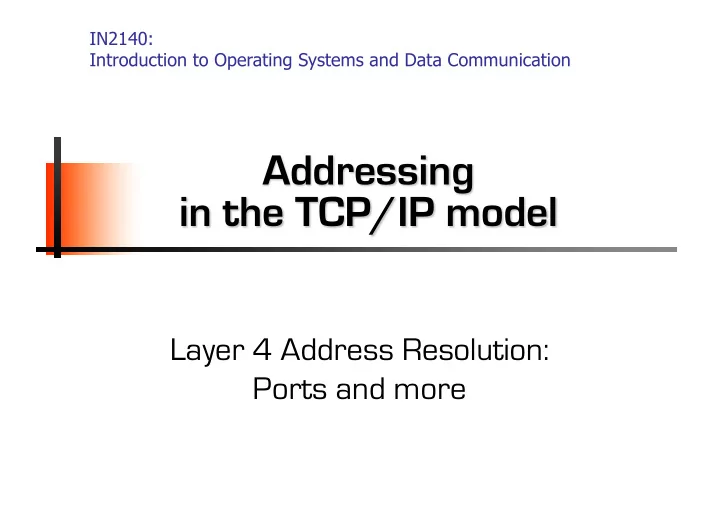

IN2140: Introduction to Operating Systems and Data Communication Addressing in the TCP/IP model Layer 4 Address Resolution: Ports and more
Transport Layer Function Transport layer tasks 5 5 Application Application Application 1. Addressing Layer Transport Transport Transport 4 4 Application Layer Layer Layer Layer Network Network Network Transport Layer 3 3 Layer Layer Layer Network 1-2 1-2 Layer University of Oslo IN2140 – Introduction to operating systems and data communication — 2
Transport Layer Function Transport layer tasks 5 5 Application Application 1. Addressing Transport Transport 4 4 Layer Layer 2. End-to-end connection management Network Network 3 3 Layer Layer 3. Transparent data transfer 1-2 1-2 between processes 4. Quality of service options • Error recovery • Reliability • Flow control • Congestion control University of Oslo IN2140 – Introduction to operating systems and data communication — 3
Transport Layer Addressing Transport Port Protocol Service Interface Addresses Application Application 5 Layer Layer TCP/IP 1. Port 2. IP address !! Transport Transport 4 Entity Entity ISO TSAP (transport service Network Network 3 access point) Layer Layer 1-2 TCP: Message, UDP: Datagram, ISO: TPDU University of Oslo IN2140 – Introduction to operating systems and data communication — 4
Transport Layer Function UDP TCP int main() int main() { { … … if((sock = socket(AF_INET, SOCK_DGRAM, 0)) < 0) if((sock = socket(AF_INET, SOCK_STREAM, 0))<0) { … } { … } … memset(&addr, 0, sizeof(addr)); memset(&servaddr, sizeof(addr)); addr.sin_family = AF_INET; addr.sin_family = AF_INET; addr.sin_addr.s_addr = INADDR_ANY; addr.sin_addr.s_addr = INADDR_ANY; addr.sin_port = htons(PORT); addr.sin_port = htons(PORT); … Connection-oriented Connectionless if(bind(sock,(struct sockaddr *)&addr, if((bind(sock,(struct sockaddr*)&addr, sizeof(addr)))<0) sizeof(addr))<0) { … } Error recovery No error recovery { … } if((listen(sock,10))<0) Reliability No reliability { … } Flow control No flow control len = sizeof(struct sockaddr_in); Congestion control No congestion control len = sizeof(struct sockaddr_in); conn = accept(sock,(struct sockaddr*)&addr,&len); n = recvfrom(sock,(char*)buffer,buflen,0, if(conn < 0) { … } (struct sockaddr*)&addr,&len); … len = sizeof(buf); i=0; sendto(sock,(char*)msg, strlen(msg), while(len>0 && n=read(conn,&buf|i],len)) 0,(struct sockaddr*)&addr,len); { i+=n; len-=n; } … if(n<=0) { … } } … write(conn,buf,1); … } University of Oslo IN2140 – Introduction to operating systems and data communication — 5
Transport Layer Function UDP TCP int main() int main() { { … … if((sock = socket(AF_INET, SOCK_DGRAM, 0)) < 0) if((sock = socket(AF_INET, SOCK_STREAM, 0))<0) { … } { … } … memset(&addr, 0, sizeof(addr)); memset(&servaddr, sizeof(addr)); addr.sin_family = AF_INET; addr.sin_family = AF_INET; addr.sin_addr.s_addr = INADDR_ANY; addr.sin_addr.s_addr = INADDR_ANY; addr.sin_port = htons(PORT); addr.sin_port = htons(PORT); … if(bind(sock,(struct sockaddr *)&addr, if((bind(sock,(struct sockaddr*)&addr, sizeof(addr)))<0) sizeof(addr))<0) { … } { … } if((listen(sock,10))<0) { … } len = sizeof(struct sockaddr_in); len = sizeof(struct sockaddr_in); conn = accept(sock,(struct sockaddr*)&addr,&len); n = recvfrom(sock,(char*)buffer,buflen,0, if(conn < 0) { … } (struct sockaddr*)&addr,&len); … Bind the port PORT to Bind the port PORT to len = sizeof(buf); i=0; sendto(sock,(char*)msg, strlen(msg), while(len>0 && n=read(conn,&buf|i],len)) 0,(struct sockaddr*)&addr,len); the socket the socket { i+=n; len-=n; } … if(n<=0) { … } } … write(conn,buf,1); But how to inform the other side about this port number? … } University of Oslo IN2140 – Introduction to operating systems and data communication — 6
Addressing at the Transport Layer What are their ports? SSH SSH DNS DNS HTTP HTTP client server client server client server Transport Network Data link Physical “Simple” answer for servers University of Oslo IN2140 – Introduction to operating systems and data communication — 7
Addressing at the Transport Layer § There is a list maintained by IANA – Internet Assigned Numbers Authority Port Number Service Service name 22 SSH Secure Shell 25 SMTP Simple Mail Transfer Protocol 53 DOMAIN Domain Name Systems 80 HTTP Hypertext Transport Protocol 110 POP3 Post Office Protocol, version 3 123 NTP Network Time Protocol 143 IMAP Internet Message Access Protocol § TCP and UDP have separate assignments − same port number – different service − The table shows some examples for TCP (read /etc/services for more) University of Oslo IN2140 – Introduction to operating systems and data communication — 8
Multiplexing task of the Transport Layer § Multiplexing and demultiplexing task of the transport layer § Example: accessing a web page with video element − Three protocols used (minor simplification) • HTTP for web page • RTSP for video control • RTP for video data port 80 Web Video Video Web port 554 server server plugin browser 5 TCP UDP UDP TCP 4 ports dynamically chosen Network Network 3 Layer Layer 1-2 University of Oslo IN2140 – Introduction to operating systems and data communication — 9
Multiplexing task of the Transport Layer § Multiplexing and demultiplexing task of the transport layer § Example: accessing a web page with video element − Three protocols used (minor simplification) • HTTP for web page • RTSP for video control • RTP for video data Web Video Video Web server server plugin browser 5 multiplexing demultiplexing TCP UDP UDP TCP 4 IP addr 1 IP addr 2 3 same IP address for all services 1-2 University of Oslo IN2140 – Introduction to operating systems and data communication — 10
Connection – Addressing • TCP service obtained via service endpoints on sender and receiver − Typically socket Server offers (IP addr/port/TCPid) − Socket number consists of a 3-tuple (80.80.1.1/80/6) • IP address of host and 80.80.1.1 • 16-bit local number (port) 80 • TCP protocol identifier • Transport Service Access Point − Port • TCP connection is clearly defined (IP addr sender/port sender/ by a 5-tuple consisting of IP addr recv/port recv/TCPid) − IP address of sender and receiver (129.3.3.3/4000/80.80.1.1/80/6) − Port address of sender and receiver − TCP protocol identifier (241.240.2.2/3210/ 80.80.1.1/80/6) 4000 • Applications can use the same local 129.3.3.3 ports for several TCP connections • if the remote side is different 4000 3210 (241.240.2.2/4000/ 80.80.1.1/80/6) 241.240.2.2 University of Oslo IN2140 – Introduction to operating systems and data communication — 11
Recommend
More recommend